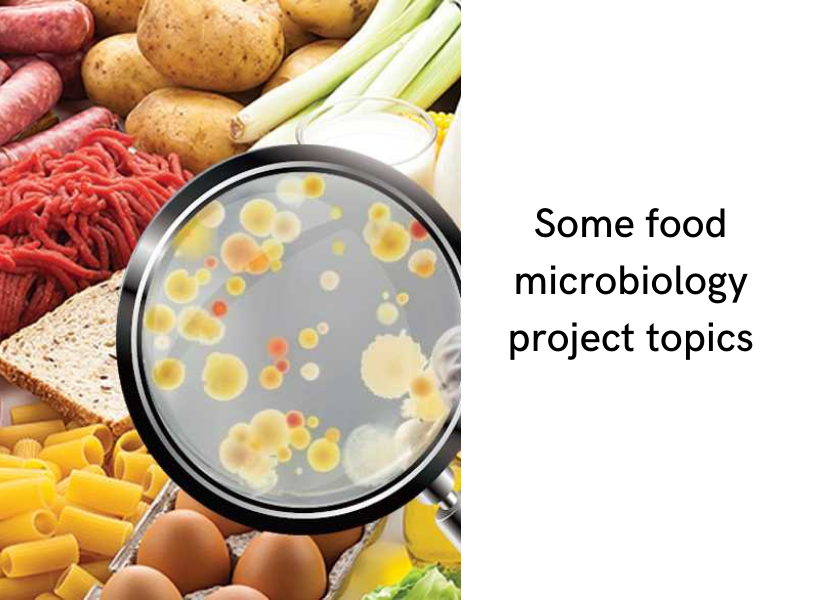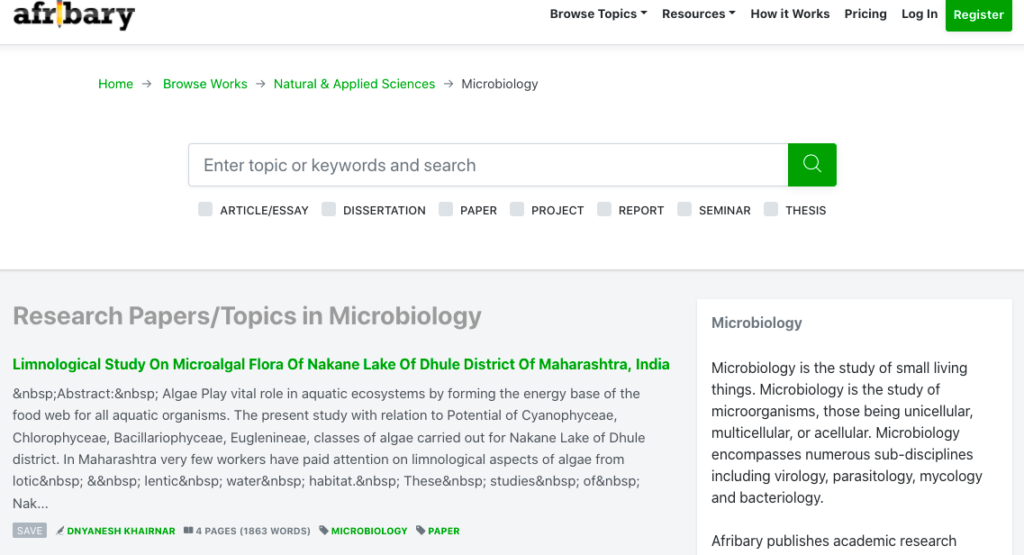As a microbiology researcher, student or postgrad you may be required to work on specifically food microbiology project topics. This means you are going to specifically be looking for only microbiology research topics that have to do with food. Food microbiology research topics will focus on research about the microorganisms that inhabit, help create or contaminate food.
So we have quickly put together a list of food related microbiology project topics (pdf & word) for you.
Before you browse through the list if you wish to search our Research Database for food microbiology project topics and materials. See below;
- Check out the Microbiology Research Section
- Enter your topic or keywords in the search space if you already have a topic
- Alternatively you can browse through and filter to get project, thesis or seminar topics
Now, for some food microbiology project topics
Ten packaged, freshly sliced watermelon were collected from different street vendors to determine their microbiological quality. Eight different microbial isolates were obtained from the sliced watermelon samples, namely Escherichia coli, Klebsiella aerogenes, Proteus mirabilis, Staphylococcus aureus, Lactobacillus spp., Saccharomyces cerevisiae, Rhizopus stolonifer and Mucor spp.
An investigation was carried out on the plasmid profile of Streptococcus lactis and Lactobacillus plantanum isolated from a total of 120 samples collected from Oyingbo, a local market in Lagos State. Morphological, cultural, physiological characterization and API kits were employed to isolate and identify and treptococcus lactis and Lactobacillus plantanum
3. Isolation And Identification of Microorganisms From Herbal Mixtures Sold at Enugu Metropolis
The safety, efficacy and quality of herbal mixtures have been an important concern for health authorities and health professional, especially now there is increase in the use of herbal mixtures. This study was aimed at isolation and identification of microorganisms from some liquid herbal mixtures sold in Enugu metropolis, South East of Nigeria.
This research work was carried out to examine the physicochemical and phytochemical constituents of honey and Shea butter samples respectively and their antibacterial effect on Staphylococcus aureus and Klebsiella pneumoniae. The physicochemical screening of honey showed that the honey samples used have low water activity, low moisture content, low pH value below 4.0 and Ash while the phytochemical analysis of Shea butter revealed the presence of Saponnins, Tannins, Alkaloids, Steroid and Phenol.
The present experiment aims at investigating the growth behaviour of different yeast strains inselected carbon, nitrogen and stress environment to obtain strains with prospects for industrialapplication. Specifically, the study is set to: isolate yeast from decaying mango fruit anddetermine growth performance of yeast strains in different environments, carbon, nitrogen andstressors.
Aquaculture has been a growing activity for the last 20 years worldwide and this impressive development has been attended by some practices potentially damaging to animal health. The bacterial infections are considered the major cause of mortality in aquaculture. Among the common fish pathogens, A. hydrophila and Y. ruckeri as gram-negative and S. agalactiae, L. garvieae and E. faecalis as grampositive bacteria cause infectious diseases.
7. MICROBIAL QUALITY ASSESSMENT OF LOCALLY PRODUCED KUNU SOLD AT TANKE AREA OF ILORIN METROPOLIS
Nine samples of freshly prepared kunu was taken from local vendors and hawkers at Tanke area, Ilorin, Kara State and analyzed for microbial quality. The pH of the samples ranged from 2.66 to 4.06. The total bacterial count ranged from 1.5×104 to 7.4×104 cfu/ml; the total coliform count ranged from 1.0×102 to 8.0x103cfu/ml; the faecal coliform count ranged from 0 to 3.0x103cfu/ml; the total fungi count ranged from 3.2×104 to 2.7x105cfu/ml. The presence of high microbial load was an indication of poor hygiene and/or poor quality cereals and water used in the preparation.
This study was carried to with the aim of determining the antibacterial effect of Calotropis procera against some bacteria isolated spoilt nunu. Bacteria isolated from spoilt nunu were identified based on their Gram characteristics, morphology and biochemical characteristics. Calotropis procera was extracted using ethanol, methanol and distilled water.
9. Antimicrobial Effect of Natural Honey and Mango Leave on Pathogenic Bacteria
Honey has since been found to possess antibacterial property and is therefore employed for wound and gastro-intestinal disease therapy. This study evaluates the antibacterial spectrum and efficacy of honey and compared with tetracycline. Different concentrations (50, 75 and 100.0 %) of honey were studied in-vitro using Staphylococcus aureus, Klebsiella spp, Escherichia coli and Citrobacter spp
The comparative evaluation of the bacterial and fungal diseases associated with Saccharum officinarum (Sugarcane) in ethnobotanical garden of Wesley University, Ondo was carried out through different microbial processes.
11. Investigating The Presence Of Staphylococcus Aureus And Escherichia Coli In Dairy Products
Dairy products are various products derived from cow’s milk or that of other female mammals such as goat, sheep, yaks, horses, camel. Dairy products include yoghurt, nono (fermented cow’s milk, madara (unfermented cow’s milk, cheese, whey, condensed and evaporated milk.) (cultureforhealth, 2015).
12. ANTIFUNGAL EFFECT OF GARCINIA KOLA
The study determines the antifungal effects of aqueous, ethanolic and methanolic extracts of Garcinia kola on some selected fungal isolates and their phytochemical constituents. The antifungal sensitivity and Minimum Inhibitory Concentration (MIC) were determined by agar well diffusion and agar dilution methods, respectively using Sabouraud dextrose agar.
Milk, Yoghurt and Cheese are highly valuable food which are readily digested and have high concentration of nutrients which have proved to be a heaven of microbes, studies were conducted on the isolation and identification of microbes [Fungi and Bacteria] on peak canned milk, yoghurt, locally prepared cheese and cheese water.
14. PRODUCTION AND QUALITY EVALUATION OF BANANA (MUSA SAPIENTUM) WINE
Juice was extracted from banana (Musa sapientum) pulp with the addition of lemon juice and was inoculated with Baker’s yeast (Saccharomyces cerevisiae) and held at 30 for seven days. The result of the yeast count increases at 48hr, and at 96hr the yeast count decreased gradually. It ranges from 4.9×107 cfu/ml at 0hr, 5.1×107 at the 48hr and 4.8×107 cfu/ml at 168hr.
15. MICROBIOLOGICAL AND MICROBIAL ASSESSMENT OF COMMERCIALLY PREPARED YOGHURTS SOLD IN ENUGU


Iam Tamilselvan now iam studying msc microbiology I need a project topics in food microbiology
by Tamil Selvan onI am given a project topic on bacteriological analysis of perishable foods sold in major markets in Calabar metropolis.
by Charity okoh onPlease I need materials on this topic
hy i am undergraduate student of biotechnolgy and i need a simple research topic related to food microbiology
by Deg R onI am manojkumar now I am studying MSc Microbiology I need a project topics in vegetable and fruits
by Manojkumar onI am a phd candidate studying food and industrial microbilogy. i need a research topic. Thanks.
by oby makuachukwu onHi I am a post graduate student (MSc) I need a project topic on food biotechnology or food microbiology
by Omekome onHello I am msc student studying food microbiology, I need project topics
by Salma Haruna onI am an Msc student food science and technology , I need project topic that is related to Probiotic or prebiotic
by Funke onYou can check https://afribary.com/works?search=&search=probiotic
by Afribary onHello, I’m MSc student, I need a project topic related to entrepreneur microbiology, under food and industrial microbiology..
by Livinus onI am an MSc student of food microbiology. I need a project topic that is related to mayonnaise production.
by Dare onI’m Rami, MSc Microbiology student I need a project topic related to food and medical
by Rami onHi I am undergraduate student of microbiology I need a sample research topic related to food microbiology
by Hassan Affan onI need a project topic on food microbiology
by Tirnom shok onPlease I need more explanation regarding this topic: evaluation of probiotics and antimicrobial potentials of lactic acid bacteria isolated from okra(soybean pulp) in soy cheese (tofu) during storage
by Blessing Archibong onI’m studying microbiology and I need a project topics under food microbiology.
by nwakudu precious on